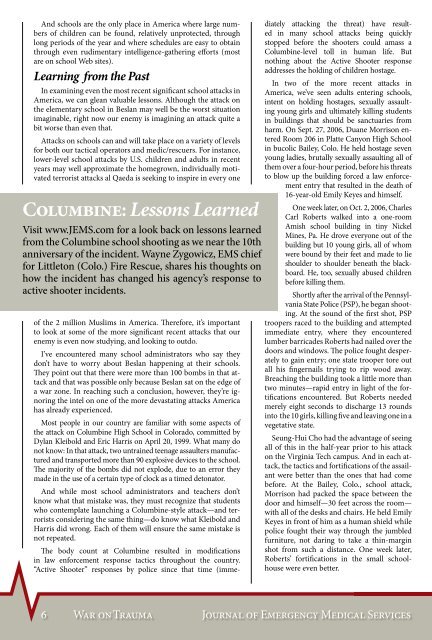Lessons Learned from a Decade of Conflict - Boekje Pienter
Lessons Learned from a Decade of Conflict - Boekje Pienter
Lessons Learned from a Decade of Conflict - Boekje Pienter
You also want an ePaper? Increase the reach of your titles
YUMPU automatically turns print PDFs into web optimized ePapers that Google loves.
And schools are the only place in America where large numbers<strong>of</strong> children can be found, relatively unprotected, throughlong periods <strong>of</strong> the year and where schedules are easy to obtainthrough even rudimentary intelligence-gathering efforts (mostare on school Web sites).Learning <strong>from</strong> the PastIn examining even the most recent significant school attacks inAmerica, we can glean valuable lessons. Although the attack onthe elementary school in Beslan may well be the worst situationimaginable, right now our enemy is imagining an attack quite abit worse than even that.Attacks on schools can and will take place on a variety <strong>of</strong> levelsfor both our tactical operators and medic/rescuers. For instance,lower-level school attacks by U.S. children and adults in recentyears may well approximate the homegrown, individually motivatedterrorist attacks al Qaeda is seeking to inspire in every oneColumbine: <strong>Lessons</strong> <strong>Learned</strong>Visit www.JEMS.com for a look back on lessons learned<strong>from</strong> the Columbine school shooting as we near the 10thanniversary <strong>of</strong> the incident. Wayne Zygowicz, EMS chieffor Littleton (Colo.) Fire Rescue, shares his thoughts onhow the incident has changed his agency’s response toactive shooter incidents.<strong>of</strong> the 2 million Muslims in America. Therefore, it’s importantto look at some <strong>of</strong> the more significant recent attacks that ourenemy is even now studying, and looking to outdo.I’ve encountered many school administrators who say theydon’t have to worry about Beslan happening at their schools.They point out that there were more than 100 bombs in that attackand that was possible only because Beslan sat on the edge <strong>of</strong>a war zone. In reaching such a conclusion, however, they’re ignoringthe intel on one <strong>of</strong> the more devastating attacks Americahas already experienced.Most people in our country are familiar with some aspects <strong>of</strong>the attack on Columbine High School in Colorado, committed byDylan Kleibold and Eric Harris on April 20, 1999. What many donot know: In that attack, two untrained teenage assaulters manufacturedand transported more than 90 explosive devices to the school.The majority <strong>of</strong> the bombs did not explode, due to an error theymade in the use <strong>of</strong> a certain type <strong>of</strong> clock as a timed detonator.And while most school administrators and teachers don’tknow what that mistake was, they must recognize that studentswho contemplate launching a Columbine-style attack—and terroristsconsidering the same thing—do know what Kleibold andHarris did wrong. Each <strong>of</strong> them will ensure the same mistake isnot repeated.The body count at Columbine resulted in modificationsin law enforcement response tactics throughout the country.“Active Shooter” responses by police since that time (immediatelyattacking the threat) have resultedin many school attacks being quicklystopped before the shooters could amass aColumbine-level toll in human life. Butnothing about the Active Shooter responseaddresses the holding <strong>of</strong> children hostage.In two <strong>of</strong> the more recent attacks inAmerica, we’ve seen adults entering schools,intent on holding hostages, sexually assaultingyoung girls and ultimately killing studentsin buildings that should be sanctuaries <strong>from</strong>harm. On Sept. 27, 2006, Duane Morrison enteredRoom 206 in Platte Canyon High Schoolin bucolic Bailey, Colo. He held hostage sevenyoung ladies, brutally sexually assaulting all <strong>of</strong>them over a four-hour period, before his threatsto blow up the building forced a law enforcemententry that resulted in the death <strong>of</strong>16-year-old Emily Keyes and himself.One week later, on Oct. 2, 2006, CharlesCarl Roberts walked into a one-roomAmish school building in tiny NickelMines, Pa. He drove everyone out <strong>of</strong> thebuilding but 10 young girls, all <strong>of</strong> whomwere bound by their feet and made to lieshoulder to shoulder beneath the blackboard.He, too, sexually abused childrenbefore killing them.Shortly after the arrival <strong>of</strong> the PennsylvaniaState Police (PSP), he began shooting.At the sound <strong>of</strong> the first shot, PSPtroopers raced to the building and attemptedimmediate entry, where they encounteredlumber barricades Roberts had nailed over thedoors and windows. The police fought desperatelyto gain entry; one state trooper tore outall his fingernails trying to rip wood away.Breaching the building took a little more thantwo minutes—rapid entry in light <strong>of</strong> the fortificationsencountered. But Roberts neededmerely eight seconds to discharge 13 roundsinto the 10 girls, killing five and leaving one in avegetative state.Seung-Hui Cho had the advantage <strong>of</strong> seeingall <strong>of</strong> this in the half-year prior to his attackon the Virginia Tech campus. And in each attack,the tactics and fortifications <strong>of</strong> the assailantwere better than the ones that had comebefore. At the Bailey, Colo., school attack,Morrison had packed the space between thedoor and himself—30 feet across the room—with all <strong>of</strong> the desks and chairs. He held EmilyKeyes in front <strong>of</strong> him as a human shield whilepolice fought their way through the jumbledfurniture, not daring to take a thin-marginshot <strong>from</strong> such a distance. One week later,Roberts’ fortifications in the small schoolhousewere even better.6War on TraumaJournal <strong>of</strong> Emergency Medical Services
















